Yves GARY Hits: 5687
Category: DESIGNERS
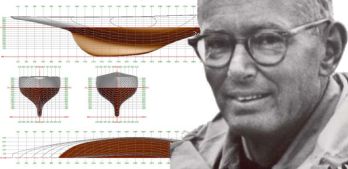 Olin J. Stephens was born on April 13, 1908 in the Bronx, New York. His father was a coal merchant who moved the family to Scarsdale, New York in 1913, where Olin and his brother Rod went to school. It was while spending summers on the New England coast that Olin first learned to sail.
Olin J. Stephens was born on April 13, 1908 in the Bronx, New York. His father was a coal merchant who moved the family to Scarsdale, New York in 1913, where Olin and his brother Rod went to school. It was while spending summers on the New England coast that Olin first learned to sail.
Graduating in 1926 from Scarsdale High School, Olin attended Massachusetts Institute of Technology for one semester only to be forced ...
... to drop out during his freshman year due to illness. He then began his yacht design career at the age of 19. He worked for some time with Henry J. Gielow, and then Philip Rhodes. By 1926 he was sailing regularly at Larchmont Yacht Club in Six Meters, a restricted-design keel boat of about 34 feet LOA and the hot racing class of the day with top-flight sailor-designers like Clinton Crane and Sherman Hoyt. 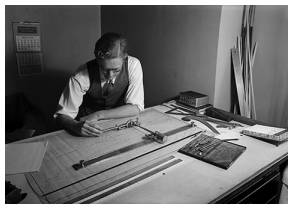
A partnership was arranged with Drake Sparkman, a yacht broker, and on November 11, 1929, Sparkman & Stephens Inc. was formally created with five partners: Drake Sparkman, James Sparkman, James Murray, Olin Stephens, and Roderick Stephens. The aggressive Sparkman was the salesman; Stephens, by nature a shy man, ran the design office. Their first project was a 21-foot LOA keel boat for junior sailing on Long Island Sound called the Sound Junior Class, later renamed the Manhasset Bay One Design (it is still sailing more than 70 years later).
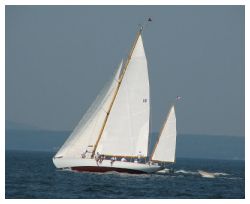 After his grandfather sold the family coal business in 1929, his father commissioned S&S design Number 7, the 52-foot yawl Dorade. Dorade was built at the Minneford Yard on City Island, N.Y., under the supervision of young Rod Stephens.In 1931 she won the transatlantic race to England against many larger boats by two days on elapsed time and also won a rough Fastnet Race. When they returned to New York, the Stephenses were given a ticker-tape parade up Broadway. Thinking Dorade too narrow and tender, when Stephens had the opportunity to design another ocean racer in 1934 he increased the beam by two feet and the result was Stormy Weather, which he regarded as the better boat. These two boats transformed the design of offshore sailing yachts.
After his grandfather sold the family coal business in 1929, his father commissioned S&S design Number 7, the 52-foot yawl Dorade. Dorade was built at the Minneford Yard on City Island, N.Y., under the supervision of young Rod Stephens.In 1931 she won the transatlantic race to England against many larger boats by two days on elapsed time and also won a rough Fastnet Race. When they returned to New York, the Stephenses were given a ticker-tape parade up Broadway. Thinking Dorade too narrow and tender, when Stephens had the opportunity to design another ocean racer in 1934 he increased the beam by two feet and the result was Stormy Weather, which he regarded as the better boat. These two boats transformed the design of offshore sailing yachts.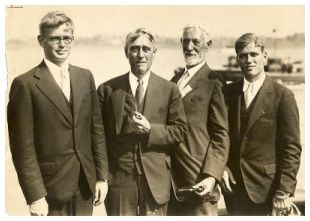 In 1930, Olin also married Susie Reynolds.
In 1930, Olin also married Susie Reynolds.
In the meantime Olin Stephens was working with Kenneth S. M. Davidson of the Stevens Institute of Technology, in Hoboken, N.J. to develop a method for evaluating a design by towing models in water tanks. It was soon used to help design an America’s Cup winner. Stephens first became involved with the America’s Cup in 1934 when he served in the afterguard of the unsuccessful defense candidate Weetamoe, designed by Clinton Crane. In 1936 Harold S. “Mike” Vanderbilt, who had defended the Cup in 1930 and 1934, brought Stephens together with W. Starling Burgess as a design team. Out of a series of tests of models, some of Burgess’s design and some of Stephens’s, came the great J-Class cutter Ranger, which dominated the 1937 America’s Cup season. She was one of the most successful racing boats of all time.
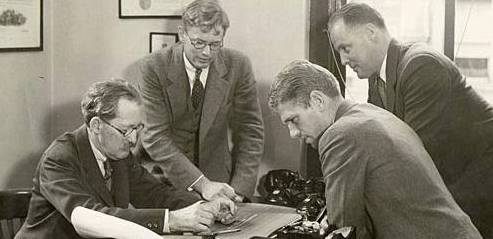 Throughout the 1930's Stephens continued to design Six Meters culminating in the very fast Goose and her near sister Llanoria, winner of Olympic gold medals in 1948 and 1952. He also designed 12-Metres and many cruiser-racers like the New York 32 class.
Throughout the 1930's Stephens continued to design Six Meters culminating in the very fast Goose and her near sister Llanoria, winner of Olympic gold medals in 1948 and 1952. He also designed 12-Metres and many cruiser-racers like the New York 32 class.
After the war, Stephens’s work expanded internationally, and S&S-designed ocean racers with different shapes won in Britain and Europe as in America. The major championships under the Royal Ocean Racing Club rating rule, including the Admiral’s Cup and One-Ton Cup, were regularly won by S&S boats. In America, the Carleton Mitchell’s 38-foot yawl Finisterre, which, beautifully prepared and brilliantly sailed by her owner and his crack crew, won three straight Bermuda Races (1956, 1958 and 1960). In the late 1960s Stephens helped bring about the first international measurement rule, the International Offshore Rule (IOR). He later served as chairman of the rule’s International Technical Committee and played an important role in the development of the International Measurement System (IMS).
 All this time Stephens was producing successful racing boats, including the winners of a total of eight of the nine America’s Cup matches between 1937 and 1980: the J-class RANGER for 1937 America's Cup, COLUMBIA (1958), CONSTELLATION (1964), INTREPID (1967 & 1970), COURAGEOUS (1974 & 1977) and FREEDOM (1980).
All this time Stephens was producing successful racing boats, including the winners of a total of eight of the nine America’s Cup matches between 1937 and 1980: the J-class RANGER for 1937 America's Cup, COLUMBIA (1958), CONSTELLATION (1964), INTREPID (1967 & 1970), COURAGEOUS (1974 & 1977) and FREEDOM (1980).
While designing America’s Cup defenders and ocean racers, Stephens also produced a number of powerboats, motorsailers and cruising boats. Stephens also was active in the design of day-racing boats, the best known of which is the Lightning, a 19 foot three-person centerboarder designed in 1938 and raced worldwide.
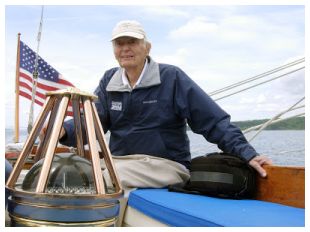 After Drake Sparkman’s death in 1964, Olin Stephens shouldered the firm’s administrative burden. His chief assistants included his brother Rod, who supervised much of the rigging design and construction, and Gil Wyland. Olin often raced in boats he designed and was in regular attendance at Newport during America’s Cup summers.
After Drake Sparkman’s death in 1964, Olin Stephens shouldered the firm’s administrative burden. His chief assistants included his brother Rod, who supervised much of the rigging design and construction, and Gil Wyland. Olin often raced in boats he designed and was in regular attendance at Newport during America’s Cup summers.
Beginning in the 1930's, Stephens nurtured a creative, independent life ashore. He studied art and painted, played the piano and read and traveled widely. He and his wife, Susie, lived in a New York suburb where they raised two sons.  On his retirement in 1978 (after designing or supervising the design of more than 2,000 boats or classes), the Stephenses moved to northern New England. Stephens continued his varied life into his nineties.
On his retirement in 1978 (after designing or supervising the design of more than 2,000 boats or classes), the Stephenses moved to northern New England. Stephens continued his varied life into his nineties.
At the age of 90, Olin Stephens completed an insightful autobiography whose title — "All This and Sailing, Too" — neatly summarized his view of life. On the last page he wrote: “In all phases of my work I was conscious of the need for balance, and I did my best to find balance in both the long and the short view. Broadly I think I can say that I applied the principles of balance in design, in business and in the pleasures I enjoyed.”
Stephens was inducted into the America's Cup Hall of Fame and awarded the Gibbs Brothers Medal from the National Academy of Sciences. In 2007, he was named as one of six inductees to the inaugural ISAF Sailing Hall of Fame. He was ranked member number 1 on the New York Yacht Club Member Seniority List. Stephens died exactly five months after celebrating his 100th birthday in 2008.

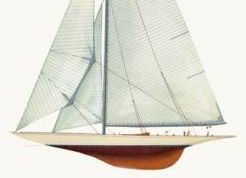 |
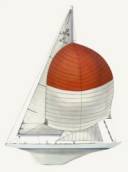 |
 |
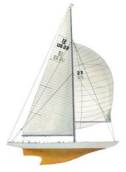 |
 |
 |
| RANGER (1937) |
COLUMBIA (1958) |
CONSTELLATION (1964) |
INTREPID (1967 & 1970) |
COURAGEOUS (1974 & 1977) |
FREEDOM (1980) |

Olin Stephens - Wikipedia, the free encyclopedia
- Profile of Olin J. Stephens - New York Yacht Club
- Olin J. Stephens II Collection (Coll. 266) - Mystic Seaport
- Inductees : Olin Stephens - ISAF Hall of Fame
- Olin J. Stephens, II, 1993 Inductee - Herreshoff Marine Museum & America's Cup Hall of Fame
- Olin J. Stephens II Dies at 100 - NYTimes.com
- Sailboat designs of Sparkman & Stephens - sailboatdata.com
